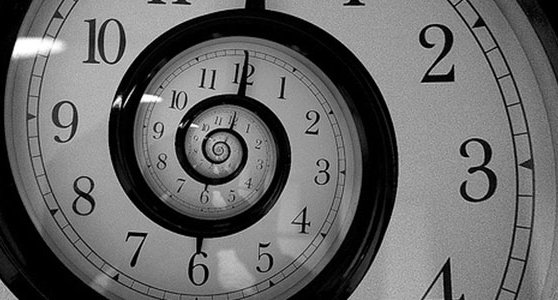A Paradox, A Mystery, A Detective Story
The Twin Paradox has been marked “Solved†and filed away in the archives of physics academia under the category “Quakeryâ€.
But not so fast. First, let me give you an analogy. There’s a very funny 2007 British comedy/mystery film. The story goes as follows. The top cop in London, loves and lives his job. He’s so good at his job that he soon gets promoted to Sergeant. However, the only open position is in a quiet village that has been named as the “Safest Place in the UK†every year for decades. The top cop’s “no nonsense†demeanor soon makes him an outcast and an object of ridicule in the new local police department and in the village as a whole. Then there’s a fatal accident. The top cop thinks there something fishy about the “accident†scene. He’s criticized as being a delusion quack – seeing evil in this long time, crime free paradise. To make a long story short, the top cop reviews the local newspaper archives and finds stories on many fatal accidents. Digging further, he finds that a group of the town’s top pillars of society has bonded together and uses murder to fend off any threat to the village’s image of peace and tranquility. The top cop brought critical thinking to an environment where most were looking at events through the lens of peace and tranquility and only the out-of-town, top cop could see the glaringly obvious.
To be able to look at the Twin Paradox mystery through clear lenses, be sure you’ve read the prior article “Part 1)â€.
“Proper Timeâ€
Before we dive into this detective story about the most basic idea in modern physics, we must introduce a very simple, but powerful physics construct, namely, “proper timeâ€. Proper time is simply the amount of time that accumulates on a clock between 2 events “very, very close†to the clock. In other words, one hour of proper time accumulates between a clock reading 1 o’clock and 2 o’clock. Further, if we manually change the clock rate for clock A to be ½ its normal rate, its accumulated proper time will be ½ that of other unmodified clocks. However, below we assume that we are dealing with identical clocks so their inherent rate for accumulating proper time is the same (other things being equal). Hence, proper time for any specific clock is inherently crisply defined with no ambiguities and further is observer independent and absolute. If we look at relativity through the lens of (absolute) proper time, we see a rather obvious loose end. If we have the audacity to pull on this loose end of modern spacetime physics, we see the very foundation of physics begin to unravel and all that is built on top begin to come apart.
Einstein’s Twin Paradox Claim
In Einstein’s 1905 paper that laid the foundation for special relativity, Einstein derived his time dilation equation and then claimed that “From this†it followed that if two clocks were together at rest in an inertial frame and then one clock made a round trip, when the “traveling clock†returned, it would have accumulated less proper time than the “stay-at-home†clock.
There immediately followed an outcry among physicists of that day complaining,
“How can one claim that ‘time dilation’ which is based on relative velocity (really on relative velocity squared) causes one clock to slow down with respect to the other clock? If the equation is applied consistently, it inherently claims that whatever effect it causes on A relative to B, it MUST cause the same effect on B relative to A!â€
This was the beginning of the Clock Paradox which was renamed the Twin Paradox in 1911.
Early relativists felt they had to address this paradox. Their reply was that since the traveling clock accelerated, special relativity’s time dilation did NOT apply to the traveling clock’s relative velocity with respect to the stay-at-home clock – although it DID STILL apply to the stay-at-home clock’s relative velocity with respect to the traveling clock!!!
The relativists who made this ad hoc assertion were very smart. However, they were glancing at the problem through the lens of “special relativity is correct and the foundation of modern physicsâ€. Hence, for them, there was no reason to look carefully at the problem – any plausible sounding rebuttal would be sufficient for those relativists who didn’t just ignore the Twin Paradox.
However, upon serious analysis, several problems with the relativists’ alleged rebuttal materialize:
One
1) The relativists’ so called “reconciliation argument†was more damning to special relativity than the paradox! If any physicist who was accelerating could NOT use special relativity, then special relativity was, for all practical purposes, useless. For example, all labs and particle accelerators on the surface of the earth are rotating and, hence, accelerating.
In addition, all empirical evidence that relativists claimed supported special relativity’s time dilation would also be empirical evidence that the relativists’ “reconciliation argument†rebuttal to the Twin Paradox was false.
Two
2) The problem is even greater than stated in 1) above. In the Twin Paradox, one can make it so that the constant velocity segments are 99.999999999999999999999999999999999999% of the total round trip. So basically the relativists’ so called “reconciliation argument†says that because the acceleration was 0.000000000000000000000000000000000001% of the round trip, one can NOT use special relativity for the traveling twin’s constant velocity parts which represent 99.999999999999999999999999999999999999% of the round trip. In other words, if one has accelerated in the past or will accelerate in the future, then one cannot use special relativity.
Three
3) Let’s look at an example of a related problem. Let’s have the start of the round trip be an arbitrarily close encounter at relative velocity v between the two twins, and their clocks, and then the twins/clocks continue separating at relative velocity v. Further, we won’t know which twin will be the “traveling twin†and be the one to turn around and return to the other twin. Hence, according to the relativists’ argument, the future decision of which twin turns around will determine which of the two clocks during the already completed, 100% symmetric separation ran slower than the other clock. In other words, the relativists’ claim is that a future event will cause one of two dramatically different pasts to materialize retroactively.
Four
4) We can expand on 3) and not only eliminate the initial acceleration, but also eliminate the turnaround acceleration and the final “decelerationâ€, The final “decelerationâ€, is replaced by another arbitrarily close encounter of the twins and their clocks, hence, there will be no “distortion†in a twin’s recording his own clock reading at this encounter due to “relative simultaneityâ€. We eliminate the turnaround acceleration by adding a “third twin†who passes the second twin who is separating from the 1st twin with relative velocity v. The 3rd twin is moving in the opposite direction and moving back towards the 1st twin with relative velocity minus v. In the arbitrarily close encounter between the 2nd and 3rd twin at the end of the “round tripâ€, they record their clock reading. Finally, using special relativity, we calculate the net proper time difference between the recorded elapsed time for the “stay-at-home†twin versus the traveling twins’ total elapsed proper time and we get the same result as for the round trip with accelerations. Hence, when you eliminate the accelerations, you still get the same basic net proper time difference! Therefore, acceleration can NOT be the cause of or explain the net proper time difference.
Five
5) Or we can take the opposite tack and have the “stay-at-home†twin do the same amount of acceleration and deceleration as the “traveling twinâ€, but do them consecutively – all together, one right after the other. In effect, the “stay-at-home†twin does a vanishingly small roundtrip. So now we have both twins do the same amount of accelerating. And again, using special relativity (or its spacetime diagrams), we’d get the same basic net proper time difference as for the standard round trip. Thus, neither adding nor subtracting accelerations affects the basic net proper time difference – in sharp contradiction to the relativists’ rebuttal argument.
Six
6) Let’s now look at two different round trips where the 1st one is a trillion times longer in duration than the second although the relative velocities between both sets of twins are equal. In other words, the starting/ending point of the 1st round trip is a trillion times further away from the turnaround midpoint than for the 2nd roundtrip. Further, let’s have midpoint turnaround accelerations for both roundtrips be arbitrarily close in space location and time.
Now the accelerations for both turnaround accelerations is the same (i.e., both go from v to –v in the same amount of time) and further both accelerations occur at virtually the same place and time. However, the relativists’ rebuttal argument requires that these two accelerations, with identical parameters, cause effects that differ by a factor of a trillion for the two clocks at rest in the stay-at-home. Does that seem fishy to you?
Seven
7) Given special relativity, there is no sound way to derive the relativists’ “reconciliation argumentâ€.
Eight
8) From tons of data we know that identical clocks, moving at the same velocity (i.e., at relative velocity 0 between each other) and at the same gravitational potential, accumulate proper time at the same rate. That’s the basis for being able to define standard time units such as the “secondâ€.
But let’s now look at two pairs of clocks involved in two separate Twin Paradox round trips in deep space. They are at the same gravitational potential so we just need to examine velocities.
In roundtrip # 1, the stay-at-home twin is at rest in the A frame and on the outbound leg of the round trip the traveling twin is at rest in the B frame (which moves at velocity v with respect to the A frame). So according to the Twin Paradox claim, clock B1 is accumulating proper time more slowly than clock A1.
Similarly, in roundtrip # 2, the stay-at-home twin is at rest in the B frame and on the outbound leg of the round trip the traveling twin is at rest in the A frame (which moves at velocity -v with respect to the B frame). So according to the Twin Paradox claim, clock A2 is accumulating proper time more slowly than clock B2.
However, the two paragraphs above can NOT both be true! It can NOT be that all the clocks in frame A are accumulating proper time at the same rate AND that all the clocks in the frame B are accumulating proper time at the same. To put it in symbolic terms, one cannot have:
A1(Rate) > B1(rate)
B2(Rate) > A2(rate)
And have both
A1(Rate) = A2(Rate) AND B1(Rate) = B2(Rate)
After reading the “killer†arguments against special relativity’s Twin Paradox claim, do you just see peaceful tranquility in spacetime physics? Or do you see something fishy that requires serious analysis? If the latter, you get an A+ in critical thinking at this stage. Obviously, the criterion for critical thinking is NOT agreeing with me – it’s being able to look at arguments and empirical data objectively and analyzing them logically while looking for scientific truth and not just confirmation of one’s current views. Some obstacles to critical thinking are being swayed by the “authority†or “reputation†of others or uncritically bowing to currently accepted views, being influenced by one’s peers and colleagues or having a vested interest (e.g., career, ego, identity, reputation, money, strongly held belief system, arrogance).
Articles in this Series
![]()









